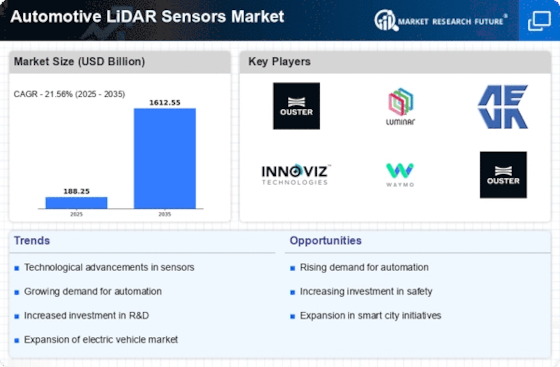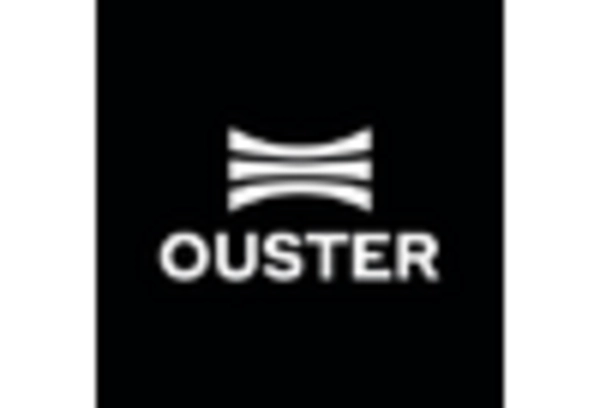Market Analysis
Automotive LiDAR Sensors Market (Global, 2024)
Introduction
The car industry is undergoing a great transformation. The car is being transformed from the era of the mechanic into the era of the electric and automatic car. The car is being equipped with a number of devices to make it safe, to make it possible to drive and to be comfortable. Among these devices are the so-called lidars. As a result of stricter regulations and greater demand for smarter cars, the industry has embraced the use of lidar technology. The current market report on the development of the lidar in the car industry will focus on the trends, technological developments and the competitive environment shaping the global market for automotive lidar sensors, as well as the factors driving innovation and investment in this critical industry.
PESTLE Analysis
- Political
- In 2024, the automobile industry is largely influenced by regulations aimed at enhancing road safety and reducing accidents. In the European Union, for example, by 2025 all new cars must be equipped with a so-called 'Advanced Driver Assist System' (ADS), which is based on LIDAR. This regulation is expected to affect 15 million cars in the European Union alone, thereby driving the demand for LIDAR sensors. In addition, the United States government has allocated $ 1,5 billion to the development of driverless vehicles, which also include LIDAR sensors, which highlights the political support for this market.
- Economic
- In 2024, the market for LiDAR sensors in the field of automobiles will be shaped by the growing investments in self-driving technology. In 2023, worldwide investments in self-driving technology reached $32 billion, and this figure is expected to increase as companies seek to improve their products. LiDAR sensors have also become much cheaper, and the cost per unit is now around $1,000. This has made them more affordable for car manufacturers. It is anticipated that this trend of falling prices will continue as a result of improvements in manufacturing processes and intensified competition among suppliers.
- Social
- Autonomous cars are increasingly accepted by society. A recent survey has shown that 60 per cent of consumers in the United States are willing to use driverless cars by 2024. This shift in public opinion is essential for the acceptance of LiDAR technology, which plays a vital role in the safety and functionality of self-driving cars. Moreover, the growing awareness of road safety, with an estimated 1.3 million fatalities from road accidents in 2022, has created a strong demand for the latest technological solutions to prevent these incidents, thus further increasing the need for LiDAR sensors in vehicles.
- Technological
- Lidar systems are rapidly developing, and their performance and cost are constantly increasing. The solid-state Lidar system is expected to hold about 40% of the market in 2024. This is because of its small size and reliability. The solid-state Lidar system is developing rapidly and some models are able to operate effectively in all weather conditions. Lidar systems are also being used with artificial intelligence to improve the data analysis. This makes it easier for the vehicle to make decisions in real time.
- Legal
- The legal framework for the market for LiDAR sensors in cars is becoming increasingly complex as a result of the ongoing development of regulations. In the United States, for example, the National Highway Traffic Safety Administration (NHTSA) is expected to issue guidelines for the testing and introduction of self-driving vehicles by 2024, which will include specific requirements for LiDAR systems. These guidelines will be binding on manufacturers and failure to comply with them will result in fines of up to $500,000. Intellectual property rights are also becoming more and more important. By 2023, over 1,000 patents had been granted for LiDAR-related technology, underscoring the intense competition in the market.
- Environmental
- Especially in the field of automobiles, the question of the environment is becoming more and more important, especially with regard to the manufacturing of LiDAR sensors. By 2024, it is estimated that one-quarter of LiDAR manufacturers will be using eco-friendly production methods, reducing their carbon footprint by up to 30 percent compared to today’s production methods. Also, the burgeoning electric vehicle market is driving the LiDAR market. By 2024, it is expected that EVs will account for 30 percent of new car sales, which will also lead to the integration of new sensors that improve safety and efficiency.
Porter's Five Forces
- Threat of New Entrants
- The threat of new entrants to the global market for automotive lidar sensors is moderate in 2024. The market is growing because of the increasing demand for self-driving cars and advanced driver assistance systems, but the high cost of research and development and the need for specialized knowledge and experience form a significant barrier to entry. The strong brand and existing customer relationships of the leading companies are an additional barrier to new entrants.
- Bargaining Power of Suppliers
- The bargaining power of suppliers in the Automotive LiDAR Sensors Market is relatively low. Suppliers in the market supply components and materials that are necessary for the production of LiDAR sensors. The number of suppliers in the market is increasing, and alternative materials are available, so manufacturers can easily change suppliers if necessary. This situation limits the suppliers’ ability to dictate terms.
- Bargaining Power of Buyers
- The bargaining power of the buyers in the global Automotive LiDAR Sensors Market is high. In this market, there are a few large automakers and technology companies. Therefore, buyers can enjoy the benefits of high-volume purchases. Also, there are a lot of choices in the market, so buyers can compare products and prices, which will further enhance their bargaining power.
- Threat of Substitutes
- The threat of substitutes in the Automotive Lidar Sensors Market is moderate. Lidar technology is well known for its accuracy and reliability in the context of autonomous driving. However, alternative sensing systems, such as radar and camera systems, are also being developed and improved. These alternatives can be substitutes, especially in certain applications, but they cannot currently match the performance of lidar in all cases.
- Competitive Rivalry
- Competition is intense in the Automotive LiDAR Sensors market. There are several major players in the market, including technology companies and suppliers to the automobile industry. Competition is intensified by the rapid development of technology and the drive to develop more efficient and cost-effective LiDAR solutions. Competition is also intense in the LiDAR market. The market is highly competitive. The companies in the market are investing heavily in innovation and marketing to differentiate their products.
SWOT Analysis
Strengths
- High accuracy and reliability in object detection and distance measurement.
- Growing demand for advanced driver-assistance systems (ADAS) and autonomous vehicles.
- Technological advancements leading to reduced costs and improved performance of LiDAR sensors.
Weaknesses
- High initial investment and production costs for LiDAR technology.
- Limited awareness and understanding of LiDAR technology among consumers and manufacturers.
- Challenges in integration with existing automotive systems and infrastructure.
Opportunities
- Expansion of smart city initiatives and infrastructure development enhancing LiDAR adoption.
- Increasing investments in research and development for next-generation LiDAR technologies.
- Potential partnerships with tech companies to enhance software and data analytics capabilities.
Threats
- Intense competition from alternative sensing technologies such as radar and cameras.
- Regulatory challenges and varying standards across different regions.
- Economic downturns affecting automotive sales and investments in new technologies.
Summary
LiDAR sensors in the automobile are characterized by the accuracy of their data and the growing demand for ADAS, but also by the high costs and the difficulties of integrating them into vehicles. Opportunities are smart city developments and R&D. Threats are competition from other sensors and regulatory hurdles. Strategically, the focus should be on cooperation and cost reduction.

















Leave a Comment